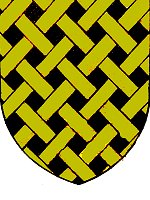yeovil people
the maltravers family
Under-Tenants, later Lords, of Hendford Manor
The Montrauers or Maltravers family was seated in Dorset. Their home was at Wellcombe, and several manors in the county testify to their possessions; Lytchet Maltravers, Loders Maltravers, Worth Maltravers, as well as Stapleford Maltravers in Wiltshire, Childrey Maltravers in Berkshire and, of course, the manor of Henford Maltravers in Somerset.
Following the Conquest in 1066 Hugh Maltravers had been under-tenant of what was to become the Manor of Hendford from William d’Eu and is named as such in the relevant entry of Domesday Book.
 Hugh
Maltravers held
of William d'Eu
six of the eight
hides which
comprised Yeovil
in 1086. The
advowson of St
John's was
finally
separated from
Hendford Manor
in 1334 and from
1339 it was
granted
absolutely to
John Maltravers.
The original
Maltravers arms
were sable,
fretty or
(on a black
field, a
continuous
golden fret).
Hugh
Maltravers held
of William d'Eu
six of the eight
hides which
comprised Yeovil
in 1086. The
advowson of St
John's was
finally
separated from
Hendford Manor
in 1334 and from
1339 it was
granted
absolutely to
John Maltravers.
The original
Maltravers arms
were sable,
fretty or
(on a black
field, a
continuous
golden fret).
After d’Eu’s fall from grace and execution, Hugh continued as under-tenant. Hugh Maltravers witnessed Henry I's charter to Montacute in the period between 1091and 1104.
In 1140 William Maltravers gave 1000 marks of silver and 100 for the widow and lands of Hugh de la Val during the term of fifteen years, and then to have the benefit of her dowry and marriage.
John Maltravers, during the reign of Henry III (reigned 1216-1272), was Custos of the King's forests and claimed to have “of every forester in the Forest of Savernake and elsewhere in the county of Wilts, at his death, his horse, saddle, and horn, bridle, sword, bow, and barbed arrows." Sir John Maltravers was Seneschal of the Household to Edward I (reigned 1272-1307) and sat in parliament. He held at his death "the manor of Chelreye, Berks, the manor of Hyneford (Hendford in Yeovil), Somerset, the manor of Wodechester, co. Glouc. the manors of Langton, Litchet, and Wichampton, co. Dorset, &c."
Another Sir John, his son, succeeded him to the manor of Hendford and in 1293 and indenture was made "between Sir John Mautravers, Knt. of the one part, and Thomas Achard of the other part, whereby the said Sir John Mautravers grants to the said Thomas an annual rent charge of five marks in his manor of Hineford near Gifle in the county of Somerset."
Sir John served in the Scottish wars and was taken prisoner at the Battle of Bannockburn in 1314. He, like his father before him, also sat in Parliament in 1327. He, however, was the Lord Maltravers involved with the death of King Edward II. In 1327 Parliament deposed Edward when he was found guilty of “incompetence; allowing others to govern him to the detriment of the people and Church; not listening to good advice and pursuing occupations unbecoming to a monarch; having lost Scotland and lands in Gascony and Ireland through failure of effective governance; damaging the Church and imprisoning its representatives; allowing nobles to be killed, disinherited, imprisoned and exiled; failing to ensure fair justice, instead governing for profit and allowing others to do likewise; and of fleeing in the company of a notorious enemy of the realm, leaving it without government, and thereby losing the faith and trust of his people.”
Edward remained in the custody of the Earl of Leicester, but Leicester was deemed to be too lenient a gaoler, so Edward was transferred to the keeping of Lord Maltravers and Lord Berkeley and taken to Berkeley Castle. In turn Lord Berkeley was considered too lenient a gaoler and was replaced by Sir Thomas Gournay who, with Maltravers, remained in charge of the King to the end. For security they moved Edward around the country but finally brought him back to Berkeley. Meanwhile the Earl of Kent was plotting to release his brother; and the Queen and the Bishop of Hereford wrote "sharp letters to his keepers, blaming them greatlie for that they dealt so gentlie with him, and kept him not streictlier;" and the Bishop added a line which Maltravers and Gourney read as an instruction to get rid of the king without leaving any marks of violence. Edward was put to death with a red hot poker up his derriere such that “his shrieks and wails moved many within the castell and the towne of Berkeley to compassion."
Nevertheless the House of Lords judged that Maltravers had not personally laid hands on the King, but employed Gournay and Ogle as his deputies. Although sentence of death was passed upon him in 1330 by the same parliament that condemned Edward's assassins, it was for a different crime - the murder of the Earl of Kent.
Meanwhile Maltravers escaped to Germany, where he remained for many years. Eventually, in 1345, he voluntarily surrendered himself to Edward III and obtained the King's permission to return to England on condition he abide by the decision of the next Parliament over his fate. In 1351 he received a full pardon and in 1352 was appointed Governor of the Channel Islands. He founded a hospital in Guernsey, and died in 1364.
The title Baron Maltravers was created in 1330 when John Maltravers was summoned to Parliament but the barony fell into abeyance among his granddaughters and coheirs, Joan and Eleanor, at his death in 1364. At the death of Joan without issue, Eleanor became de jure Baroness Maltravers. She was the wife of John Fitz Alan, a younger son of the Earl of Arundel. As a consequence the advowson of Yeovil passed to the Arundels.